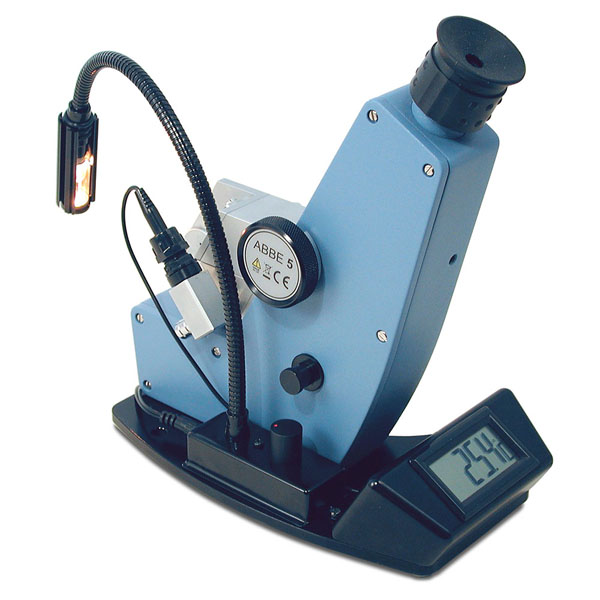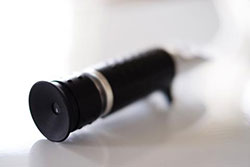A Wide Measuring Range
 The Abbe 5 optical refractometer is an affordable bench-top instrument perfectly suited for users requiring a wide measurement range of Refractive Index. Customers that use an Abbe 5 are often based in smaller contract laboratories or use them for applications where sample throughput is relatively low. The instrument is also perfect for practical demonstrations and experiments in chemistry and physics laboratories of schools, colleges and universities.
The Abbe 5 optical refractometer is an affordable bench-top instrument perfectly suited for users requiring a wide measurement range of Refractive Index. Customers that use an Abbe 5 are often based in smaller contract laboratories or use them for applications where sample throughput is relatively low. The instrument is also perfect for practical demonstrations and experiments in chemistry and physics laboratories of schools, colleges and universities.
The Abbe refractometer derives its name from the 19th Century physicist and father of modern optical technology, Ernst Abbe (1840- 1905). He was the co-founder of the Carl Zeiss Jena Optical Company and Schott Glasswerk. Abbe designed an instrument for measuring dispersion which became the precursor for a refractometer – the Abbe Refractometer.
Traditional Abbe refractometers have both Transmission and Reflection modes of illumination.
Transmission Mode of Illumination
As the name implies, refractometers adopting the transmission mode of illumination allow the light to pass THROUGH the sample. The light source is either incorporated as part of the refractometer or is generated by a sodium or spectral lamp outfit.
Reflection Mode of Illumination
This method of illumination works from the principle that the angle of reflected light equals that of the transmitted light. As such, the light reaches the interface of prism/sample, most of the light is transmitted out of the instrument in the normal way, however, some light is reflected. This reflected light is far less brilliant than the transmitted light but it does equal the same angle and as such may be used to interpret the Refractive Index.
Reflective mode is particularly useful for measuring samples with high optical density e.g. rubber and polymers.
It’s worth noting that modern digital Refractometers adopt only one mode of illumination - Reflection mode. By using reflected light, digital handheld refractometers such as the OPTi can be made more compact and in some instances waterproof. However, reflected light is less brilliant and so can be difficult to see with the human eye. Optical instruments such as the Abbe 5 and handheld refractometers like the Eclipse primarily adopt transmitted light, either by way of natural or artificial light sources.
For Academia, Research and General Laboratory Applications
The Abbe 5 is a traditional optical refractometer that features both Refractive Index and Brix scales, with a resolution of 0.0005 and 0.1 respectively. The temperature of the prism is monitored electronically and displayed on the clear LCD display at the base of the instrument. Connections for a water-bath provide optional prism temperature control, facilitating accurate readings to 4 decimal places RI (or for Brix, 1 decimal place). Dispersion measurements of solid materials such as glass, contact lenses and fibre optics may be made in accordance with standard practice.
You can use an Abbe 5 optical refractometer to measure the refractive index (and °Brix) of many different samples. The Abbe 5 is particularly useful when wanting to measure resins (including set resins) as well as very viscous samples such as confectionary including boiled sweets and gummy sweets (e.g. gummy bears and jelly babies).
Abbe 5 Optical Refractometers Key Features
- Dual Scale
- Refractive Index & 0-95 Brix
- Dispersion Measurement
- Optional Light Source
Order today direct from Refractometer Shop and benefit from our knowledgeable customer care team and free delivery direct from the manufacturer, or contact us today for more information and local dealerships.
Handheld Optical Refractometers
 The Eclipse optical refractometer is recognised by many as one of the world’s most reliable and robust optical refractometers available today. Manufactured in Europe at Bellingham + Stanley’s well-equipped factory, Eclipse refractometers feature a bright field of view, a unique sample “dribble feed” and are sealed against moisture ingress.
The Eclipse optical refractometer is recognised by many as one of the world’s most reliable and robust optical refractometers available today. Manufactured in Europe at Bellingham + Stanley’s well-equipped factory, Eclipse refractometers feature a bright field of view, a unique sample “dribble feed” and are sealed against moisture ingress.
A selection of scale types covering a wide range of common applications including fruit ripeness and salinity within food and beverage, and glycol measurement in industrial are available from within the Eclipse range. The Eclipse also caters for zoologists and entomologists with a unique Low Volume Brix with the capability of measuring samples of less than 1-microlitre such as nectar.
Eclipse Handheld Optical Refractometers Key Features
- Clear “easy-to-read” scales
- Smooth eyepiece adjustment
- Calibration adjustment
- Well balanced in the hand
- Durable rubber grip
- Replaceable prism flap
- IP65 water resistant